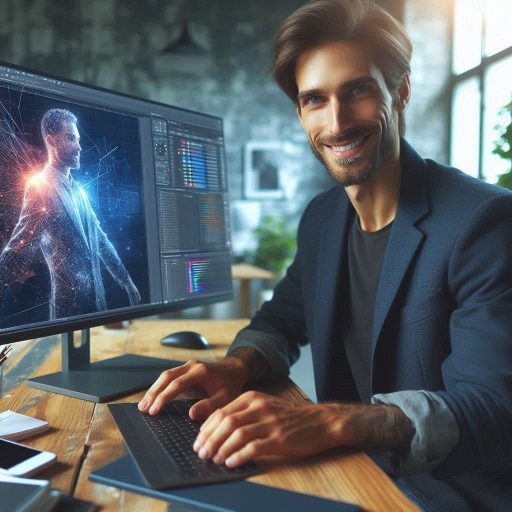Introduction
Becoming a successful ceramic artist requires a combination of creativity, technical ability, and dedication.
This field demands both artistic vision and the practical skills necessary to bring ideas to life.
Aspiring ceramic artists must develop a variety of skills to succeed in creating functional or decorative pieces.
Ceramic art is experiencing growing popularity, with more people appreciating the uniqueness of handmade items.
As the demand for handcrafted ceramics increases, so do the opportunities for artists.
From pottery studios to online markets, ceramic artists can showcase and sell their creations in numerous ways.
Creativity is at the heart of ceramic art.
Artists need to visualize and design pieces that reflect their unique style. A strong sense of design helps ceramic artists create balanced and aesthetically pleasing works.
Technical Skills
Mastering the technical aspects of working with clay is essential.
Artists must learn how to shape, glaze, and fire ceramics.
This includes understanding kiln temperatures, clay types, and glazing techniques.
Attention to detail is critical in creating high-quality ceramic pieces.
Artists need precision when crafting intricate designs, ensuring each piece meets their artistic standards.
Ceramic art requires patience.
It can take time to perfect techniques and master the craft.
Artists must persevere through challenges and continuously practice their skills.
To succeed commercially, ceramic artists need business skills.
Marketing, pricing, and networking are vital for selling artwork and building a brand.
By honing these essential skills, aspiring ceramic artists can thrive in this creative and rewarding field.
Creativity and Imagination
Creativity and imagination are essential skills for a ceramic artist because they allow for innovative and unique designs to be brought to life.
Transform Your Career Today
Unlock a personalized career strategy that drives real results. Get tailored advice and a roadmap designed just for you.
Start NowArtists who possess these qualities are able to push boundaries, experiment with different techniques, and create pieces that truly stand out in the world of ceramic art.
Importance of Creativity and Imagination in Ceramic Art
Without creativity and imagination, ceramic art would become stagnant and repetitive.
These skills are what set individual artists apart from one another and allow for personal expression to shine through in each piece created.
They are the driving force behind innovation and progress in the field of ceramic art.
Examples of How Creative Thinking Enhances Work as a Ceramic Artist
- Experimenting with new glazing techniques to create unique textures and finishes.
- Combining traditional ceramic forms with unconventional materials for a modern twist.
- Using inspiration from nature, architecture, or personal experiences to inform design choices.
Nurturing and Developing Creativity in Ceramic Art
There are several ways to nurture and develop creativity in the context of ceramic art:
- Take inspiration from other artists and art forms to spark new ideas.
- Experiment with different techniques and materials to expand your skill set.
- Step outside of your comfort zone and try new approaches to creating ceramic art.
- Keep a sketchbook or journal to capture fleeting ideas and inspirations.
- Collaborate with other artists to gain fresh perspectives and insights.
By actively engaging in these practices, ceramic artists can continue to grow and evolve their creative abilities, leading to more dynamic and compelling work.
Read: Creating Art for Video Games: A Digital Artist‘s Guide
Technical Skills
The technical skills required for working with clay and other materials used in ceramic art
To succeed as a ceramic artist, mastering technical skills is crucial.
First, working with clay requires a deep understanding of its properties.
Knowing how to handle and shape it ensures the creation of strong, durable pieces.
Artists must also learn to manipulate other materials, such as glazes and slips, to enhance their work.
The process of creating ceramic pieces, including throwing, hand-building, glazing, and firing
The process of creating ceramic pieces involves several techniques.
Throwing on the wheel allows artists to shape symmetrical forms with precision.
Hand-building, on the other hand, involves crafting pieces without a wheel, offering more design flexibility.
Glazing is essential to finish pieces, adding color, texture, and a protective layer.
Lastly, firing in a kiln is a critical step that solidifies the clay and glaze, turning the work into a permanent ceramic piece.
Recommend resources and tools for improving technical skills in ceramic art
Improving technical skills requires continuous learning and practice.
Books and online tutorials offer valuable insights into various ceramic techniques.
Classes and workshops provide hands-on experience and expert guidance.
For beginners, investing in basic tools like a pottery wheel, carving tools, and a kiln is essential.
Transform Your Career Today
Unlock a personalized career strategy that drives real results. Get tailored advice and a roadmap designed just for you.
Start NowThese tools allow artists to practice and refine their craft.
In short, becoming a skilled ceramic artist demands mastery of working with clay, proficiency in various techniques, and a dedication to continual learning.
By practicing consistently and using the right tools and resources, artists can elevate their technical skills and create beautiful, lasting pieces of art.
Read: Using Social Media to Promote Digital Art
Attention to Detail
The significance of attention to detail in creating high-quality ceramic art
Attention to detail is crucial for creating high-quality ceramic art.
Every intricate design, curve, and texture contributes to the final piece’s beauty and value.
Artists must carefully consider the shape, symmetry, and finishing of their work.
In ceramic art, even small mistakes can affect the overall look and functionality of the piece.
Tips for maintaining precision and accuracy throughout the creative process
Maintaining precision and accuracy requires patience and focus.
Ceramic artists should regularly check their measurements and proportions during the process.
Using proper tools and techniques, like calipers or templates, can help ensure uniformity in repetitive patterns or shapes.
Developing a routine to review and refine each step of the creation helps artists stay consistent.
Examples of how attention to detail can elevate a ceramic artist’s work
Additionally, paying attention to the drying, glazing, and firing stages is essential.
Slight changes in temperature or material application can drastically alter the outcome.
Ceramic artists must remain vigilant, especially when experimenting with new glazes or clay types.
For example, a vase with an intricate carved design can be transformed by a precisely applied glaze.
The attention to detail in smoothing edges and refining patterns will make the piece stand out.
Moreover, taking the time to correct small imperfections before firing can prevent cracks or weak spots.
In essence, attention to detail can elevate a ceramic artist’s work from ordinary to extraordinary.
By focusing on precision and accuracy throughout the creative process, artists can produce stunning, high-quality pieces that showcase their skills.
Transform Your Career Today
Unlock a personalized career strategy that drives real results. Get tailored advice and a roadmap designed just for you.
Start NowMastering this important skill ensures each piece reflects the artist’s dedication to craftsmanship.
Read: Building a Strong Brand as a Digital Artist

Patience and Perseverance
The importance of patience in mastering the craft of ceramic art
Patience is essential in mastering the craft of ceramic art.
Each step in the process requires focus and time.
Whether it’s shaping clay, waiting for pieces to dry, or glazing, rushing can ruin the work.
Ceramic artists must develop patience to perfect their skills and produce high-quality art.
The challenges that ceramic artists may face and the perseverance required to overcome them
The challenges faced by ceramic artists are numerous.
The clay may crack, glazes might not turn out as expected, or pieces could break in the kiln.
These setbacks can be discouraging, but perseverance is key.
Artists need to learn from failures, refine their techniques, and push forward.
Overcoming these challenges builds resilience, improving skills and fostering personal growth.
Strategies for staying motivated and committed to artistic growth
Staying motivated and committed to artistic growth requires intentional strategies.
Setting clear goals helps artists stay focused on improvement.
Breaking large projects into smaller, manageable tasks keeps progress steady.
Additionally, seeking feedback from peers and mentors can offer valuable insights.
Regular practice, coupled with learning from mistakes, will build confidence over time.
Maintaining a positive mindset is also crucial for long-term success.
Viewing failures as learning experiences rather than setbacks keeps artists motivated.
Taking breaks when needed to recharge can prevent burnout and maintain passion.
By staying patient and persevering through obstacles, ceramic artists can reach new heights in their craft.
Transform Your Career Today
Unlock a personalized career strategy that drives real results. Get tailored advice and a roadmap designed just for you.
Start NowUltimately, patience and perseverance are the foundation of success in ceramic art.
Each failure is an opportunity for growth, and consistent effort will lead to mastery.
Read: Networking Tips for Aspiring Character Designers
Knowledge of Art History and Techniques
The value of studying art history and learning traditional ceramic techniques
Studying art history and traditional ceramic techniques is essential for aspiring ceramic artists.
It helps them understand the origins of their craft and enhances their artistic vision.
By learning about ancient methods, artists can appreciate the evolution of ceramic art and gain inspiration from past masters.
How familiarity with different styles and movements can influence a ceramic artist’s work
Familiarity with various art styles and movements influences an artist’s work in meaningful ways.
By exploring diverse historical periods, ceramic artists can infuse their creations with unique elements.
This knowledge allows them to blend traditional and modern approaches, creating pieces that are innovative yet grounded in history.
Recommendations for books, courses, and museums to expand one’s knowledge in this area
To deepen your understanding of art history and ceramic techniques, consider several resources.
Books like The Ceramics Bible by Louisa Taylor and Ceramics: Contemporary Artists Working in Clay by Kate Singleton provide valuable insights.
Online courses such as those offered by Skillshare and Coursera can help you build foundational skills.
Additionally, visiting renowned museums, such as The Met in New York and the British Museum in London, offers exposure to important ceramic works from different cultures and eras.
By immersing yourself in art history, you can broaden your creative perspective and enhance your technical skills.
This knowledge will enable you to experiment with various styles, develop your artistic voice, and create truly original works.
Explore Further: Lighting Design for Art Galleries and Museums
Business and Marketing Skills
The business side of being a ceramic artist, including pricing, marketing, and selling one’s work
Being a successful ceramic artist requires not only artistic talent but also strong business skills.
Understanding pricing, marketing, and selling your work is essential to sustain a profitable career.
Properly pricing your ceramics ensures that you cover your costs while valuing your time and effort.
Consider market trends, material costs, and your target audience when setting prices.
Transform Your Career Today
Unlock a personalized career strategy that drives real results. Get tailored advice and a roadmap designed just for you.
Start NowWithout a thoughtful pricing strategy, your profits may suffer.
Advice on how to build a brand as a ceramic artist and attract clients or customers
Marketing your ceramic pieces effectively helps attract potential buyers and build a loyal customer base.
Utilize social media platforms, websites, and online shops to showcase your work.
Consistently sharing high-quality images of your creations can boost engagement and reach a wider audience.
Craft fairs, galleries, and exhibitions also offer opportunities for artists to connect with collectors and clients.
Resources for learning about the business aspects of the art industry
Building a personal brand is crucial to standing out in a competitive market.
Develop a unique artistic style and message that represents your work.
A cohesive brand makes it easier for clients to recognize and remember your art.
Consider creating a professional portfolio or website that highlights your best work and tells your story.
Strong branding builds trust with customers and helps grow your reputation.
To thrive in the business side of ceramics, it’s important to continuously learn about art industry practices.
Attend workshops, webinars, and courses focused on business skills for artists.
Books, podcasts, and blogs can also provide valuable insights into marketing strategies and selling art.
Learning from other artists‘ experiences will help you navigate the challenges of running a ceramic business.
Mastering business and marketing skills ensures that your passion for ceramics translates into a successful career.
Conclusion
Becoming a successful ceramic artist requires mastering key skills.
Strong creativity is essential to craft unique and compelling designs.
A deep understanding of materials and techniques helps artists work efficiently with clay and other substances.
Hand-eye coordination is crucial for shaping intricate details, while patience ensures quality work throughout the long creative process.
Continuous development of your skills is critical.
Transform Your Career Today
Unlock a personalized career strategy that drives real results. Get tailored advice and a roadmap designed just for you.
Start NowAlways seek opportunities to learn new methods, refine your style, and grow as an artist.
Whether through workshops, online tutorials, or mentorship, keep expanding your knowledge and expertise.
The ceramic arts field constantly evolves, so staying updated and innovative can help you stand out.
Pursuing your passion for ceramic art can be a fulfilling journey.
Every creation you complete contributes to your personal growth and artistic identity.
Challenges will arise, but overcoming them brings a sense of accomplishment and artistic maturity.
A career in ceramic art offers profound rewards.
It allows you to express creativity, connect with a community, and create functional, beautiful pieces.
The joy of seeing your vision realized in tangible form is priceless.
Embrace the ups and downs of this career, knowing that each step leads to personal fulfillment.
In the end, becoming a ceramic artist requires honing creative and technical skills, embracing growth, and staying passionate.
Never stop learning, experimenting, and pursuing your love for the art.
The journey may be challenging, but the rewards‘both personal and professional‘are immense.
[E-Books for Sale]
The Big Book of 500 High-Paying Jobs in America: Unlock Your Earning Potential
$19.99 • 500 High-Paying Jobs • 330 pages
Explore 500 high-paying jobs in America and learn how to boost your career, earn more, and achieve success!
See All 500 High-Paying Jobs of this E-Book
1001 Professions Without a Degree: High-Paying American Jobs You Can Start Now
$19.99 • 1001 Professions Without a Degree • 174 pages
Discover 1001 high-paying jobs without a degree! Unlock career tips, skills, and success strategies for just $19.99!




